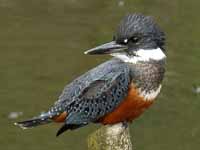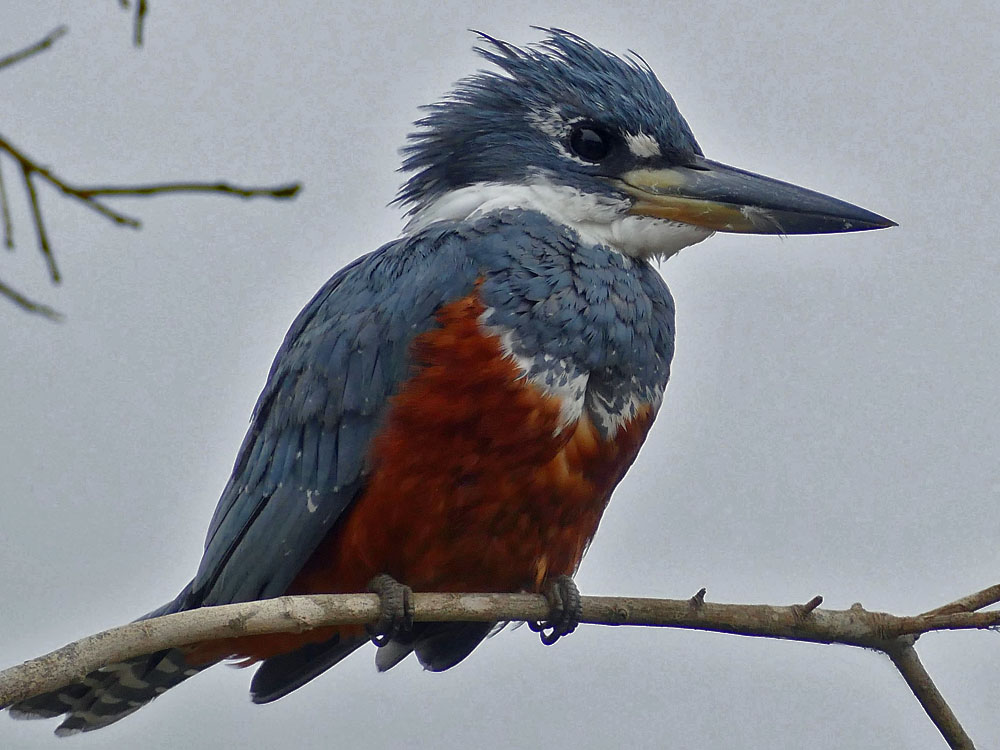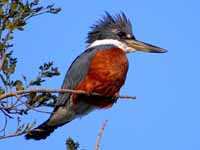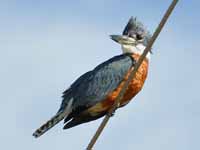THE WORLD BIRDS - An Online Bird Book
KINGFISHERs of The World - Water Kingfishers
Order Coraciiformes Family Alcedinidae
KINGFISHERs of The World - Water Kingfishers
Order Coraciiformes Family Alcedinidae
The kingfisher family Alcedinidae belongs to the Coraciiformes order, as do the bee-eaters of family Meropidae, the motmots of family Momotidae, the rollers of families Brachypteraciidae and Coraciidae, and the todies of family Todidae.
Kingfishers are a group of small to medium sized brightly colored birds in the order Coraciiformes. They have a cosmopolitan distribution, with most species found outside of the Americas. There are about 110 species of kingfisher. All have large heads, long, sharp, pointed bills, short legs, and stubby tails. The typical kingfisher has three toes pointing forward and one to the rear, with the third and fourth toes partially fused together. The bill is usually longer and more compressed in species that hunt fish, and shorter and more broad in species that hunt prey off the ground. Most species have bright plumage with little differences between the sexes. There is also little difference in the length or weight of the sexes. Some species have males slightly larger than females, but other species have the females listed as slightly larger than the males.
The kingfishers are separated into three subfamilies: River Kingfishers (Alcedinina), Tree Kingfishers (Halcyoninae), and Water Kingfishers (Cerylinae). This article is about the Water Kingfishers.
The water kingfishers are one of the three subfamilies of kingfishers. Of the nine kingfishers that belong to this family, one is found in Africa, two in Asia, and the other six in the Americas. All American kingfisher species are in this family. These are all fish-eating species, unlike many representatives of the other two subfamilies. In addition to fish, some also eat crustaceans, insects, tadpoles, and reptiles. They usually seize their prey by diving from a perch. Some will occasionally hover briefly while searching for prey and others can catch insects on the fly. Because these kingfishers favor food from water, they prefer habitats near water. All the water kingfisher will visit fresh water locations, a few will also frequent salt water.
As is true for all kingfishers, the water kingfishers have their nests in cavities. In this case, the cavities are almost always created by excavating nest-tunnels in earth bankings. They lossen the material with their bill and move the material to the rear via their forward facing toes, two of which are partially fused toes. With the young living in a nest which is enclosed tunnel, it can get rather gross in those tight quarters. The parents are known to take a bath immediately after feeding the chicks!
All of the water kingfishers have a conservation status of Least Concern. One reason for their success is that they all have ranges that are geographically large. Another reason is that they are not fussy where they excavate their nest - some sort of banking will do. Contrast this to many of the tree kingfishers of subfamily Halcyoninae which excavate their nests in termite mounds.
Genus Ceryle - 1 species
Kingfisher,_Pied Ceryle rudis
Description: The pied kingfisher is black and white. It has upperparts barred black-and-white, white underparts with a black breast-band, and a black eye-mask. The male has a wide black collar and a thin lower breast collar. The female has a broken black collar. It is 25 to 30 cm long and weighs 70 to 110 grams with the female slightly bigger than the male. The pair, perhaps with a helper, excavate a 1 to 2.5 meter long tunnel in a banking. The female incubates the eggs and the male feeds her and the chicks.
The pied kingfisher has a clearly defined neck marks compared to thesimilar crested kingfisher or giant kingfisher which have smudged breast-bands.
Range: Africa, Southern Asia from Turkey to India to China.
Habitat: Fresh waterbodies, coasts, marshes.
Diet: Mainly fish; also crustaceans, insects.
Conservation status: Least Concern.
Image by: 1, 4) Arno Meintjes 3) Andy_Li 3) Frans_Vandewalle - The GambiaRange: Africa, Southern Asia from Turkey to India to China.
Habitat: Fresh waterbodies, coasts, marshes.
Diet: Mainly fish; also crustaceans, insects.
Conservation status: Least Concern.
1, 2) Female 3) Male
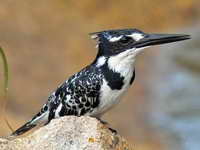

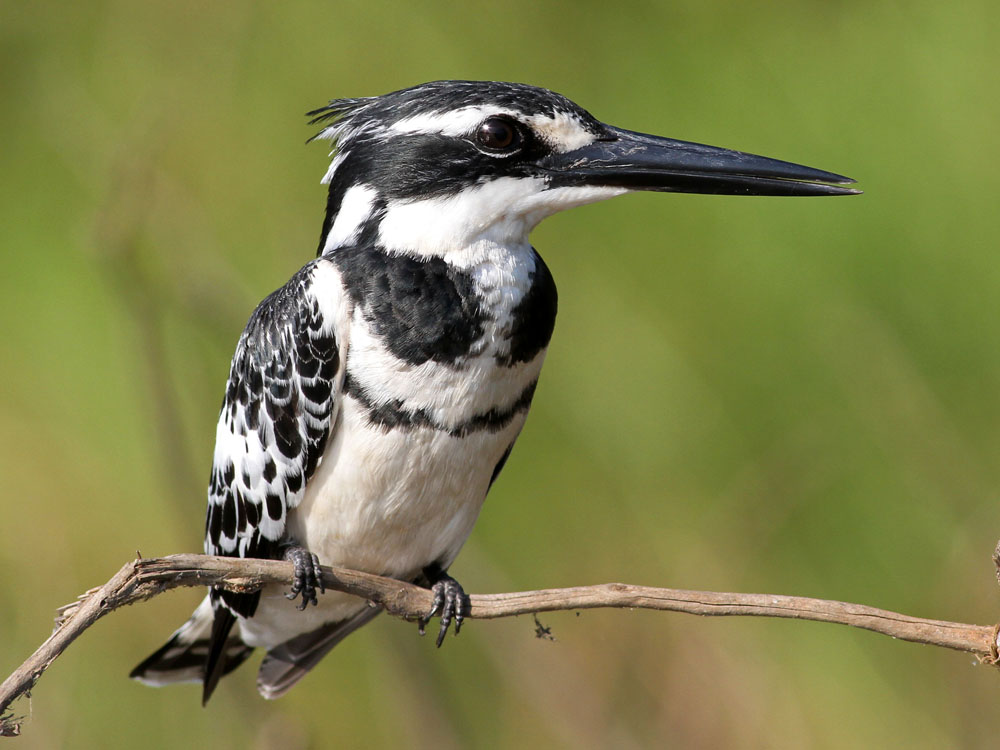
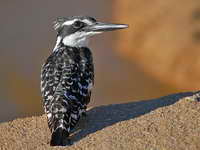
Genus Chloroceryle
All the Chloroceryle kingfishers usually nest in a horizontal earth-banking tunnel and have green upperparts. The four species in this genus are found in tropical Americas and all have fish as their favorite food. They are widely different in size with the smallest the American pygmy kingfisher 13 cm long and the largest the Amazon kingfisher 30 cm long. The green kingfisher is 20 cm long and the green-and-rufous kingfisher is 24 cm long. Their ranges overlap, but because of their size differences they do not compete with each other for the same food supply.
Kingfisher,_Amazon Chloroceryle amazona
Description: The Amazon kingfisher is large and heavy: 30 cm long and 100 to 140 grams. It has dark green upperparts including the head. The collar and belly are white. The male has a wide rufous breast-band while the female has a wide broken green breast-band. The pair excavates a tunnel, usually near water, that is 45 cm long. The female incubates eggs by night, and the male during the day. Incubation period is 22 days; fledge 4 weeks latter.
It is similar to the green kingfisher which is considerably smaller. The male green kingfisher has a proportionally wider breast-band than his counterpart.The female green kingfisher has 2 breast-bands while her counterpart has 1 broken breast-band.
Range: Southern Mexico to northern Argentina.
Habitat: Fresh waterbodies, coasts, estuaries.
Diet: Mainly fish; also crustaceans. Dives from a perch to seize prey. May also hover over water to find the prey.
Conservation status: Least Concern.
Image by: 1) Carlos_Henrique 2) Nick Athanas - Columbia, Brazil 3) Andreas_TrepteRange: Southern Mexico to northern Argentina.
Habitat: Fresh waterbodies, coasts, estuaries.
Diet: Mainly fish; also crustaceans. Dives from a perch to seize prey. May also hover over water to find the prey.
Conservation status: Least Concern.
1, 2) Female 3) Male
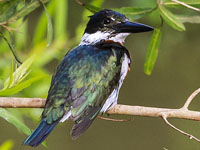
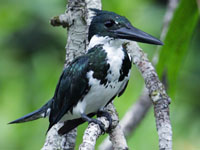
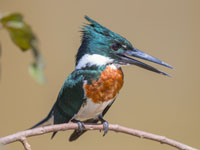
Kingfisher,_America_Pygmy Chloroceryle aenea
Description: The American pygmy kingfisher is a very small kingfisher at 13 cm of length and weighing 10 to 16 grams. It has dark green upperparts with faint white dots, a dark green head, yellow-orange collar, rufous breast and flanks, plus a white center of the belly. The female has a narrow green breast-band. They have a black bill with a yellow base to the lower-bill. They excavate a 30 t0 40 cm nest-tunnel in a banking or create a smaller one in an arboreal termite mound. It is similar to the green-and-rufous kingfisher which has a rufous belly,
Range: Southern Mexico to much of South America.
Habitat: Dense forests and mangrove swamps along small streams or rivers with heavily vegetated banks.
Diet: Small fish or tadpoles; also insects. They dive for prey in the water and catch insects on the fly.
Conservation status: Least Concern.
Image by: 1) Carol Foil - Belize 2) Nick Athanas - Costa Rica 3) Jerry Oldenettel - Belize 4) Francesco_Veronesi - BrazilRange: Southern Mexico to much of South America.
Habitat: Dense forests and mangrove swamps along small streams or rivers with heavily vegetated banks.
Diet: Small fish or tadpoles; also insects. They dive for prey in the water and catch insects on the fly.
Conservation status: Least Concern.
1, 2) Female 3, 4) Male
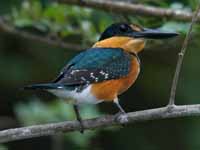
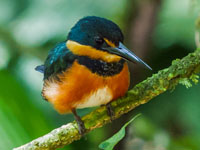
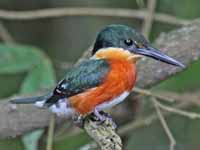
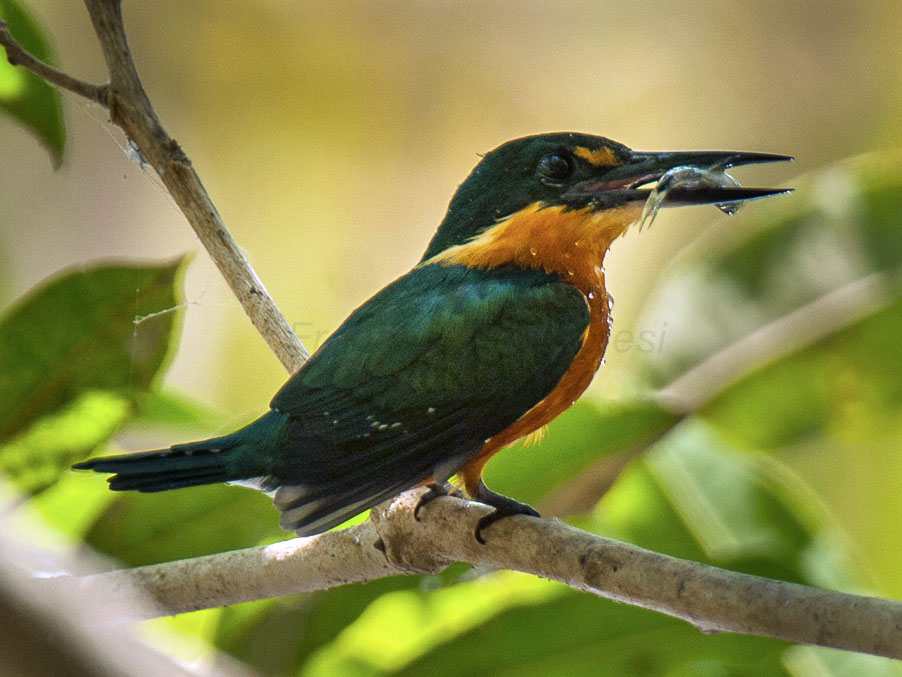
Kingfisher,_Green Chloroceryle americana
Description: The green kingfisher has dark green upperparts including the head. It has a white collar and belly, plus a black bill. The male has a rufous breast while the female has two green breast-bands. They are 20 cm in length and weigh 35 to 40 grams. They excavate a 70 to 100 cm long nest-tunnel in a earthen banking. They loosen the material with their bill and move the material to the rear via their 2 forward facing and partially fused toes. The male green kingfisher is differentiated from the male ringed kingfisher by his white belly and he is differentiated from the Amazon kingfisher by having more red on his breast. The female green kingfisher is differentiated from similar female kingfishers by her 2 green breast-bands.
Range: Southern Texas, through Central America, to Argentina in South America.
Habitat: Fresh water with trees or brush for perching.
Diet: Mainly fish; also aquatic insects.
Conservation status: Least Concern.
Image by: 1, 4) Jerry Oldenettel - Costa Rica 2) Nick Athanas 3) Cláudio Dias Timm - BrazilRange: Southern Texas, through Central America, to Argentina in South America.
Habitat: Fresh water with trees or brush for perching.
Diet: Mainly fish; also aquatic insects.
Conservation status: Least Concern.
1, 2) Female 3, 4) Male
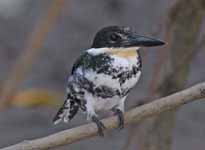
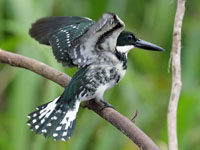
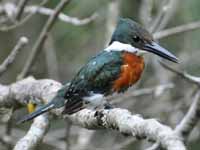
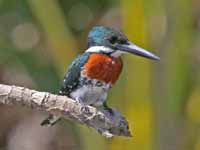
Kingfisher,_Green-and-rufous Chloroceryle inda
Description: The green-and-rufous kingfisher has dark green upperparts with light spots on the wings, a dark green head, pale yellow lores, plus a rufous collar and rufous underparts. The female has a green breast-band. They are 24 cm long and weigh 45 to 62 grams with the female bigger. The similar but smaller American pygmy kingfisher has a white belly.
Range: Nicaragua to southern Brazil.
Habitat: Near streams and rivers with the banks well vegetated.
Diet: Fish, crustaceans, aquatic insects.
Conservation status: Least Concern.
Image by: 1) Tom_Benson - Costa Rica 2) Becky_Matsubara - Costa Rica 3) Arthur Chapman - Bolivia 4) Nick Athanas - BrazilRange: Nicaragua to southern Brazil.
Habitat: Near streams and rivers with the banks well vegetated.
Diet: Fish, crustaceans, aquatic insects.
Conservation status: Least Concern.
1, 2) Female 3, 4) Male
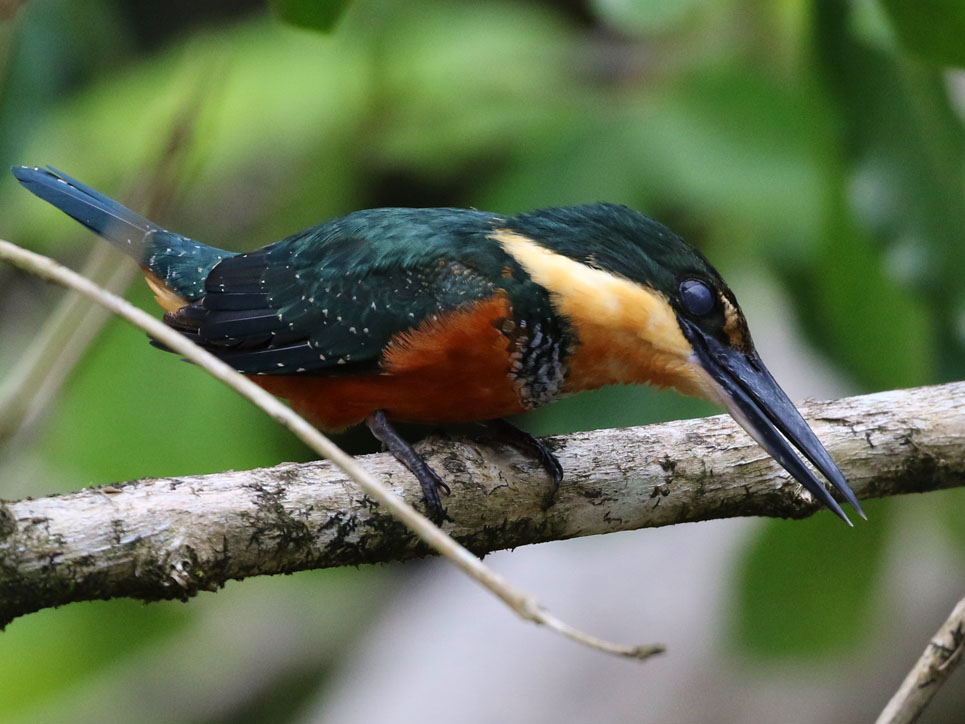
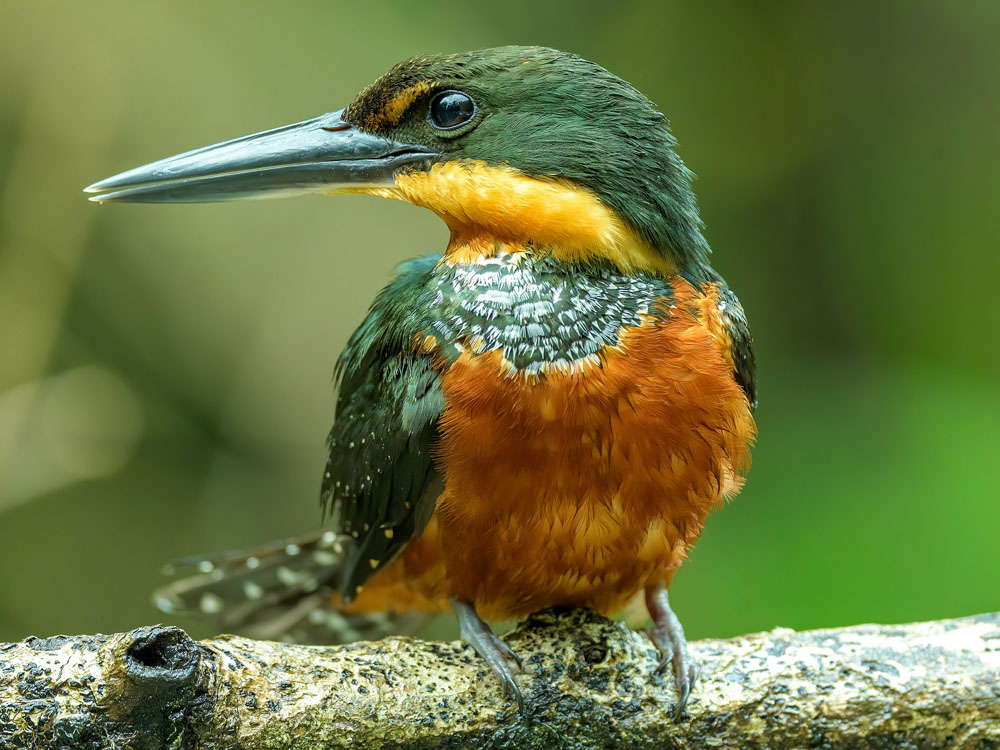
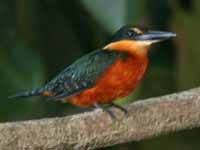
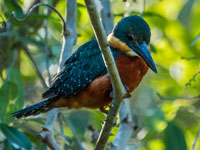
Genus Megaceryle
All are fish eaters. They have a prominant head creast, grey or greyish-blue upperparts, and white or rufous underparts. The underparts pattern is always different for the two sexes. They are all relatively large, with the giant kingfisher challenging the laughing kookabuura of Australia for the title of the world's largest kingfisher.
Kingfisher,_Belted Megaceryle alcyon
.Description: The belted kingfisher has a dark blue to black head and back. It has a crest, white collar, blue breast-band, and white belly. The female has a rufous lower breast-band that extends to her flanks. It is 28 to 35 cm long and weighs 110 to 180 grams with the female slightly larger than the male. The pair excavates a nesting-tunnel in an earthen bank that is near their fishing site. The tunnels are usually 30 cm to 2 meters long. Its underparts can be used to differentiate the belted kingfisher from similar species such as the green kingfisher or ringed kingfisher.
Range: North America to northern South America.
Habitat: Near fresh or salt water that has good visibility for sighting prey. Perches such as tree limbs are also necessary.
Diet: Mainly fish. Also crustaceans, insects, mollusks, reptiles.
Conservation status: Least Concern.
Image by: 1) Elaine R Wilson - British Columbia 2) mike_baird - california 3, 4) Andy_MorffewRange: North America to northern South America.
Habitat: Near fresh or salt water that has good visibility for sighting prey. Perches such as tree limbs are also necessary.
Diet: Mainly fish. Also crustaceans, insects, mollusks, reptiles.
Conservation status: Least Concern.
1, 2) Female 3, 4) Male
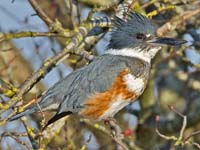


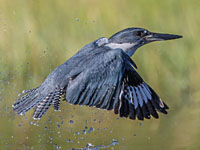
Kingfisher,_Crested also Himalayan Pied kingfisher Megaceryle lugubris
Description: The crested kingfisher is very large with a length of 41 to 43 cm and weight of 230 to 280 grams The upperparts have black-and-white barring. It has a crested head, white underparts with a black and white breast-band, and white lores. The bill is black with a pale base. The male has some rufous on the breast-band. The pair excavates a nest-tunnel 2 to 3 meters long. The similar pied kingfisher has a clearly defined breast-band while the crested kingfisher's is smudged breast.
Range: Southern Asia.
Habitat: Moving water.
Diet: Fish, crayfish.
Conservation status: Least Concern.
Image by: 1) Caesar Photography 2) LonelyShrimp 3) Tokumi - JapanRange: Southern Asia.
Habitat: Moving water.
Diet: Fish, crayfish.
Conservation status: Least Concern.
1,2) Female 3) Male
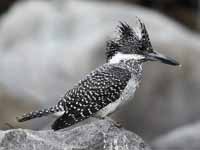
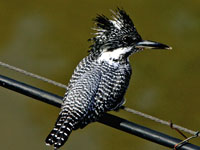
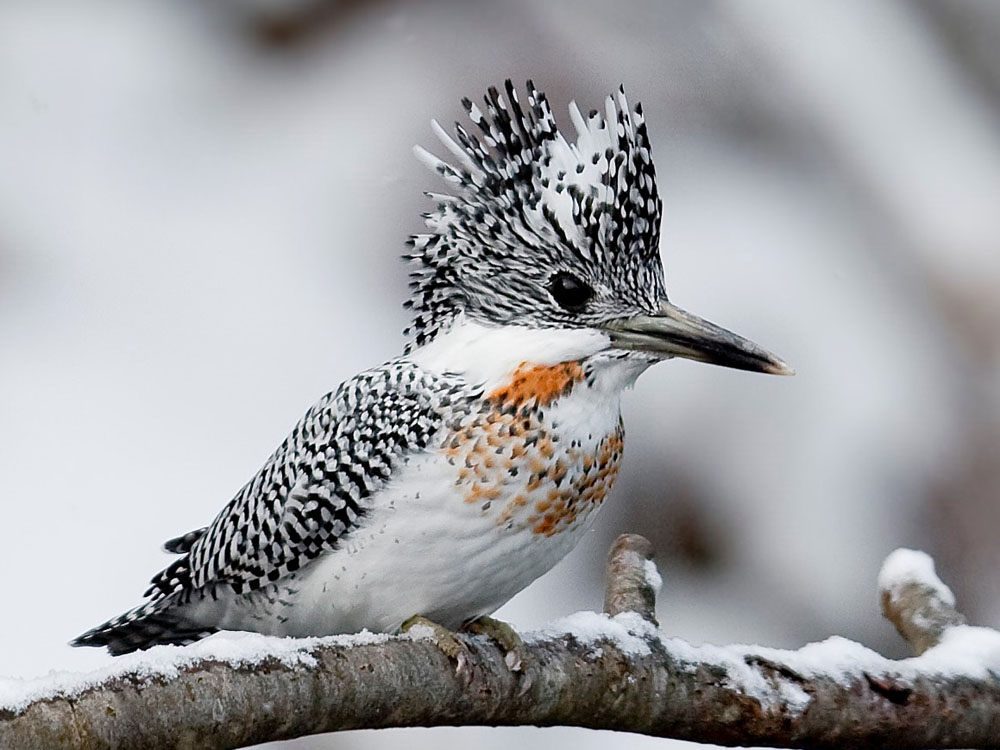
Kingfisher,_Giant Megaceryle maxima
Description: The giant kingfisher has blue or black upperparts with white freckles, and a white collar. The male has a chestnut breast-band, plus black spots on the white belly. The female has a black-spotted white breast-band and chestnut belly. This is the largest African kingfish with a length of 42 to 46 cm and a weight of 250 to 425 grams. The male averages larger than the female. A horizontal tunnel, typically 2 meters long, is excavated into a river bank by both sexes using their feet and bills. The similar pied kingfisher has clearly defined neck collar marks while the giant kingfisher has a smudged breast-band.
Range: Africa.
Habitat: Near water, both fresh and salt.
Diet: Fish, crabs, frogs obtained by diving from a perch.
Conservation status: Least Concern.
Image by: 1) Martin Heigan 2) Frans_Vandewalle - The Gambia 3) Arno Meintjes 4) Charles_J_Sharp - KenyaRange: Africa.
Habitat: Near water, both fresh and salt.
Diet: Fish, crabs, frogs obtained by diving from a perch.
Conservation status: Least Concern.
1, 2) Female 3, 4) Male


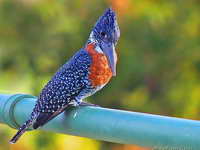
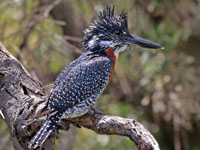
Kingfisher,_Ringed Megaceryle torquata
Description: The ringed kingfisher has deep blue or greyish-blue upperparts and head, plus a white collar,The male has rufous underparts. The female has a wide grey breast-band which is bordered below with white, and a rufous belly. This is a large kingfisher with a length of 28 to 35 cm and a weight of 140 to 170 grams. The pair excavates a nest-tunnel about 2 meters into a banking. The ringed kingfisher has more red on its underparts than the similar green kingfisher.
Range: Texas to South America.
Habitat: Near waterbodies that include streams, rivers, ponds, lakes, estuaries and marine habitats.
Diet: Mainly fish; also crustaceans.
Conservation status: Least Concern.
Image by: 1) Jorge Cardenas - Chile 2) Bernard_Dupont - Brazil 3) Dario
Sanches - Brazil 4) Claudio Timm - BrazilRange: Texas to South America.
Habitat: Near waterbodies that include streams, rivers, ponds, lakes, estuaries and marine habitats.
Diet: Mainly fish; also crustaceans.
Conservation status: Least Concern.
1, 2) female 3, 4) Male
